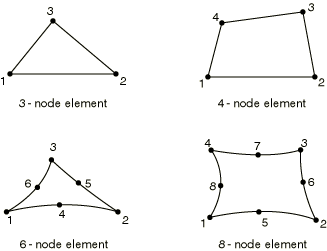Distributed loads are specified as described in
Distributed Loads.
Gravity, centrifugal, rotary acceleration, and Coriolis force loads apply only
if the surface elements have rebar defined or if the elements have a defined
density.
*dload
-
Load ID (*DLOAD):
BX
-
FL−2
-
Body force in the global X-direction.
-
Load ID (*DLOAD):
BY
-
FL−2
-
Body force in the global Y-direction.
-
Load ID (*DLOAD):
BZ
-
FL−2
-
Body force in the global Z-direction.
-
Load ID (*DLOAD):
BXNU
-
FL−2
-
Nonuniform body force in the global X-direction with
magnitude supplied via user subroutine
DLOAD in
Abaqus/Standard
and
VDLOAD in
Abaqus/Explicit.
-
Load ID (*DLOAD):
BYNU
-
FL−2
-
Nonuniform body force in the global Y-direction with
magnitude supplied via user subroutine
DLOAD in
Abaqus/Standard
and
VDLOAD in
Abaqus/Explicit.
-
Load ID (*DLOAD):
BZNU
-
FL−2
-
Nonuniform body force in the global Z-direction with
magnitude supplied via user subroutine
DLOAD in
Abaqus/Standard
and
VDLOAD in
Abaqus/Explicit.
-
Load ID (*DLOAD):
CENT
(S)
-
FL−3
(ML−2T−2)
-
Centrifugal load (magnitude is input as ,
where
is the mass density per unit area,
is the angular speed).
-
Load ID (*DLOAD):
CENTRIF
(S)
-
T−2
-
Centrifugal load (magnitude is input as ,
where
is the angular speed).
-
Load ID (*DLOAD):
CORIO
(S)
-
FL−3T
(ML−2T−1)
-
Coriolis force (magnitude is input as ,
where
is the mass density per unit area,
is the angular speed). The load stiffness due to Coriolis loading is not
accounted for in direct steady-state dynamics analysis.
-
Load ID (*DLOAD):
GRAV
-
LT−2
-
Gravity loading in a specified direction (magnitude is input as
acceleration).
-
Load ID (*DLOAD):
HP
(S)
-
FL−2
-
Hydrostatic pressure applied to the element reference surface and linear in
global Z. The pressure is positive in the direction of the
positive element normal.
-
Load ID (*DLOAD):
P
-
FL−2
-
Pressure applied to the element reference surface. The pressure is positive
in the direction of the positive element normal.
-
Load ID (*DLOAD):
PNU
-
FL−2
-
Nonuniform pressure applied to the element reference surface with magnitude
supplied via user subroutine
DLOAD in
Abaqus/Standard
and
VDLOAD in
Abaqus/Explicit.
The pressure is positive in the direction of the positive element normal.
-
Load ID (*DLOAD):
ROTA
(S)
-
T−2
-
Rotary acceleration load (magnitude is input as ,
where
is the rotary acceleration).
-
Load ID (*DLOAD):
SBF
(E)
-
FL−5T2
-
Stagnation body force in global X-,
Y-, and Z-directions.
-
Load ID (*DLOAD):
SP
(E)
-
FL−4T2
-
Stagnation pressure applied to the element reference surface.
-
Load ID (*DLOAD):
TRSHR
-
FL−2
-
Shear traction on the element reference surface.
-
Load ID (*DLOAD):
TRSHRNU
(S)
-
FL−2
-
Nonuniform shear traction on the element reference surface with magnitude
and direction supplied via user subroutine
UTRACLOAD.
-
Load ID (*DLOAD):
TRVEC
-
FL−2
-
General traction on the element reference surface.
-
Load ID (*DLOAD):
TRVECNU
(S)
-
FL−2
-
Nonuniform general traction on the element reference surface with magnitude
and direction supplied via user subroutine
UTRACLOAD.
-
Load ID (*DLOAD):
VBF
(E)
-
FL−4T
-
Viscous body force in global X-,
Y-, and Z-directions.
-
Load ID (*DLOAD):
VP
(E)
-
FL−3T
-
Viscous surface pressure applied to the element reference surface. The
pressure is proportional to the velocity normal to the element face and
opposing the motion.

